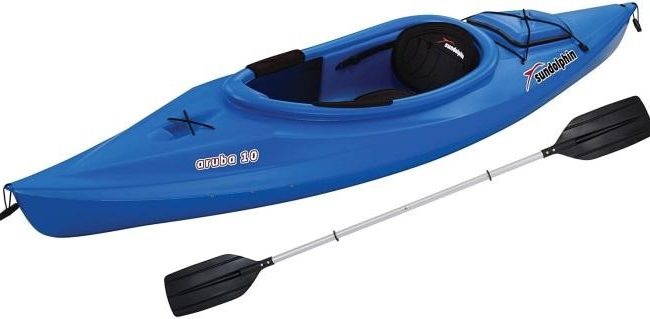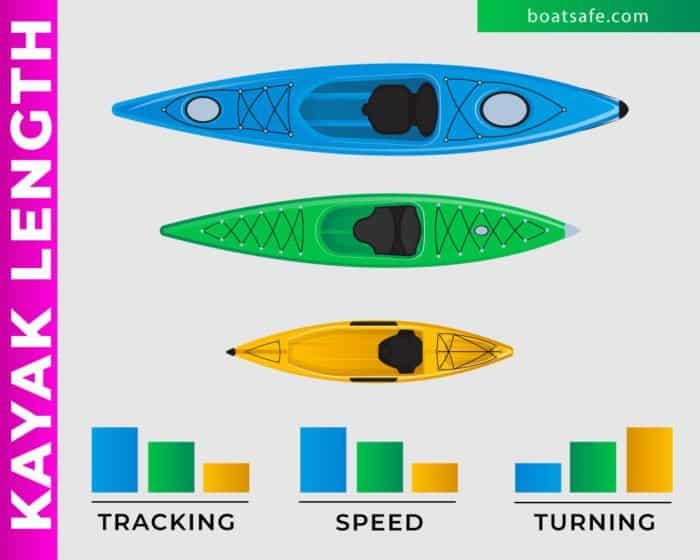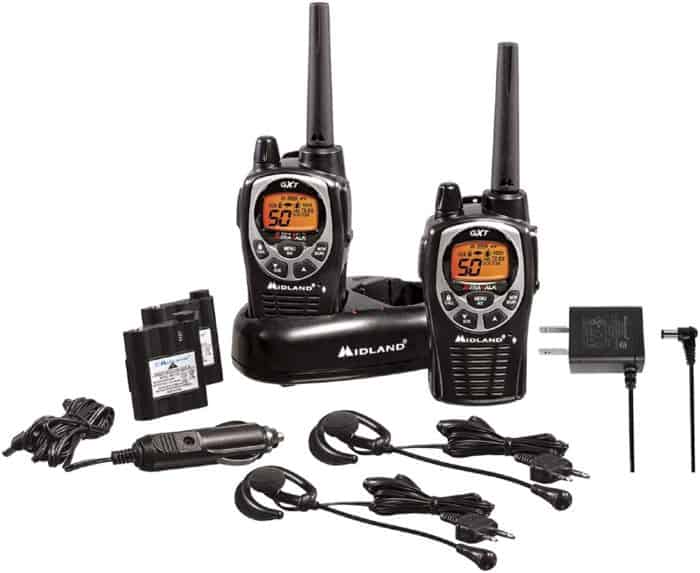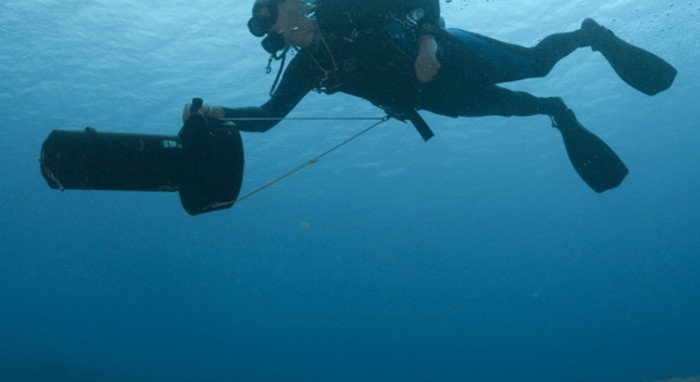Choosing the Optimal Kayak Length – Height Chart Included
Does size matter? The age-old question indeed.
Kayaking is one of the most enjoyable and rewarding hobbies you can take up. It is borderline addictive, whether you want to do it for leisure, fishing, or touring, relaxing weekends with family and friends spent out on the lake, or to get your adrenaline pumping when battling whitewater rapids. There’s something for everyone.
The challenge for most people comes when trying to figure out the best kayak size to go with, more specifically, in terms of its length. If this is the dilemma you’re currently facing, you’ve come to the right place to find the answers you seek.
We’ve put together the ultimate guide for choosing the optimal boat size along with a kayak length for height chart you can use to determine the best one to get for your specific activity.
Factors to Consider When Choosing the Optimal Kayak Size
The size of the kayak is arguably one of the most important aspects to consider when buying one. This will have a large bearing on the capabilities and limitations on the activities you can take part in. Here’s what you need to think about.
1. What Is the Purpose of Kayaking
The first thing you need to identify is what you intend to do with the kayak you buy. This will advise what size kayak you should get. The optimal kayak length for a boat you plan to use on the calm still waters of a lake is vastly different from what you would need to navigate whitewater rapids safely and efficiently.
Kayaking in a sea or ocean environment, for instance, calls for a kayak that offers a high level of stability to prevent the powerful waves from capsizing your vessel. Larger and longer boats are ideal for such environments.
On the flip side, these would not be ideal for navigating rapids. You would require a much shorter kayak to make fast turns, increase the level of control, and enhance agility – something you just don’t get with bulky boats.
2. What Length to Width Ratio Is Ideal
Once you figure out where you intend to kayak, the next aspect of choosing the optimal kayak size has to do with the length to width ratio of the vessel in question. This is the single most critical factor in determining how stable the kayak will be.
You need to establish how the length and width of the hull affect the way the vessel sits on the water, as well as how well it balances. You also need to understand how this ratio affects the kayak’s performance in terms of speed and maneuverability.
As a rule, it is always better to avoid a kayak with an extremely thin hull if you haven’t mastered the art of balancing. The extra speed and efficiency you get mean nothing if you constantly tip over sideways every couple of feet!
3. Legroom
To get the most out of your kayaking experience, you’re going to need ample legroom. Ignoring this critical element of the kayak purchasing process is the single biggest mistake you can make.
You want a snug fit, but not so tight that it impedes your ability to quickly get in and out of the vessel. This is important in emergencies.
You also don’t want too much legroom as this gives you less control over the vessel. You won’t be able to maneuver it quite as easily. The ideal length is somewhere in between.
Different Types of Kayaks and Their Dimensions
There are several different types of kayaks, each of which is designed to allow users to derive the maximum utility from them. We’ll explore three types of kayaks and what the typical dimensions for each of them are.
Recreational Kayaks

Most of the recreational kayak designs you’ll come across are the sit-on-top variety. They are built specifically for leisure use and maximum comfort. This makes them ideal for spending a weekend afternoon gliding along the lake to escape the hustle and bustle of day-to-day life.
For this reason, recreational kayak designs don’t make storage a priority. So, they tend to be shorter than other types of kayaks. They are also built to be much wider to offer better stability.
The lengths of most vessels in this category tend to be 12 feet and under, with a kayak’s width that ranges anywhere between 27 to 36 inches.
Sit-in recreational kayaks tend to be slightly longer and wider than their sit-on-top cousins by 36 inches and 20 inches for the length and width, respectively. A top recreational kayak worth checking out is the 10-foot Sun Dolphin Aruba sit-in kayak.
Fishing Kayaks

Fishing kayaks, or anglers as they are commonly called, are designed to offer lateral stability. This is necessary when shuffling on the boat and casting fishing lines. So, there’s no risk of the boat tipping over in the process.
Anglers are usually longer than recreational kayaks and measure between 10 and 14 feet in length, and 42 inches wide. If you’re in the market for a fishing kayak, then you might like the Lifetime Tamarack Angler 100.
Sea and Touring Kayaks

Kayaks in this category tend to be quite long and narrow, to traverse long distances on the water with ease. Their design also allows for more storage space for carry-ons.
They are built to be seaworthy and provide maximum comfort for the longer durations spent out at sea. On the flip side, the tradeoff for their speed and design is stability and maneuverability. Shorter boats tend to perform better in that regard.
Sea and touring kayaks typically measure anywhere between 12 and 20 feet in length and 18 to 24 inches in width. Tandems are usually longer measuring up to 24 feet in length. A popular touring kayak many sea lovers are crazy about is the Pelican Maxim sit-in kayak. It’s worth checking out.
Does The Length of a Kayak Matter
Contrary to what you might believe, a kayak’s length does not play a significant role in evaluating its performance potential. What you do need to be concerned about are the dimensions of the cockpit as opposed to the actual physical length of the boat.
Now, for the most part, people under 6 ft. in height will fit in conventional sit-in kayak cockpits. If you’re taller than that, then it’s always a good idea to test a 12 to 14-foot kayak to get a feel for the fit , seat height, and the legroom available.
This is because taller people tend to have:
- A higher center of gravity
- Longer legs
- Bigger feet (particularly for the men)
Having a higher center of gravity may affect your stability when sitting in your kayak. Longer legs may also mean having a wider waist and hips. So, the cockpit dimensions you need to be concerned with are – the cockpit opening length and width.
These tell you whether you’ll be able to get in and out of the kayak comfortably and with ease, without scraping your knees in the process. If you have to wiggle yourself in, it’s a sign that the opening is too small for you.

Kayak Length for Height Chart
Use this chart to guide you on the vessel size you should get based on how tall you are.
| Height | Weight | Suitable for: | |
| Low Volume Kayak | < 5 ft. 6 in. | < 140 lbs. | Day excursions with a minimal amount of gear |
| Medium Volume Kayak | 5 ft. 7 in. – 5 ft. 10 in. | 150 lbs. – 180 lbs. | Overnight trips with a moderate amount of gear |
| High Volume Kayak | > 5 ft. 10 in. | > 180 lbs. | Trips that last more than a day with essential gear for the duration |
Kayak Volume – What Does It Mean
It is important to understand whether the kayak volume indicated by the manufacturer is ideal for you. This gives you a better idea of how much room you can expect inside the boat. Kayak makers typically use four terms to describe volume:
- Low Volume – These are designed for paddlers under 5 ft. 6 in. tall weighing less than 140 lbs.
- Medium Volume – They are made for paddlers between 5 ft. 7 in. and 5 ft. 10 in. tall weighing between 140 and 189 lbs.
- High Volume – These are built for paddlers over 5 ft. 10 in. tall weighing more than 180 lbs.
- Cubic Feet or Gallons – This is the actual physical space inside the vessel.
The only true way to know if a kayak’s volume is ideal for your height is to sit in it. That way you’ll get a feel for how it fits your length and trunk size. Nonetheless, you could always use a kayak length for a height chart for reference.
Pick the Best Kayak for Your Height
Keep in mind that the kayak length for the height chart detailed in this guide is meant to serve as a guide for the paddler. Its recommendations are not set in stone.
A high volume kayak, for instance, would be suitable for a 6 ft. tall guy of average build. But, if the same guy weighed 165 lbs., does it mean he should get a medium volume model? Probably not, since it might cramp his long legs.
So, while the chart is a useful tool, paddler height always trumps weight capacity, when choosing the best kayak for your needs.
Need more information on how to choose a kayak? Check out our blog to learn how.
Categories: Reviews












6 Comments
Nancy Holtz Carter on April 21, 2021
Iam a 5’6″adult. Weight 130lb, can I fit in a youth Kayak? Specifically a 6’Kayak. The 8′ are to heavy.
Paul Glantz on July 14, 2023
Calling it close my daughter 5 4 110 fits perfect
Jackie Flood on May 27, 2021
Nancy, I just started kayaking last year, so I don’t have much experience. I did find that an 8′ sit on top yak seemed to handle better for me than the 6′ youth model I purchased. I am 5’3″ and 100#s. The 8′ felt more stable, so I sold the youth model and bought the 8′ Lifetime Lotus. It weighs just under 40# (almost half my weight) and I attached a tie down strap from front to rear to carry it. I can carry it using my body/legs and arms; so it can be done.
Ken on June 13, 2021
I am 6’5″” and weigh 190lbs. I am looking for a sot fishing kayak. Any suggestions?
theresa on June 13, 2021
? What should I get if I weigh 195 and I am 5,3
Javier on January 19, 2023
Somebody can tell me if I can safely transport a 14” kayak on my 12.5” car roof using a Thule kayak rack? Or is it too risky even using Thule ties and additional ends tie downs to front and back?